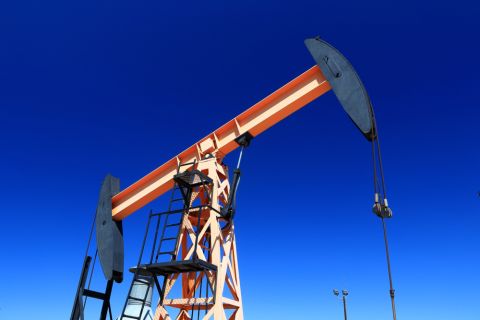
Oil prices hit $80 a barrel on May 17 for the first time since November 2014 on concerns Iranian exports could fall, reducing supply in an already tightening market.
Brent crude futures hit $80 and stood up 57 cents at $79.85/bbl at 0955 GMT.
U.S. West Texas Intermediate (WTI) crude futures were up 64 cents at $72.13/bbl, also their highest since November 2014.
The prospects of a sharp drop in Iranian oil exports in the coming months due to renewed U.S. sanctions following President Donald Trump's decision to withdraw from an international nuclear deal with Tehran has lifted oil prices in recent weeks.
France's Total on May 16 warned it might abandon a multi-billion-dollar gas project in Iran if it could not secure a waiver from U.S. sanctions, casting further doubt on European-led efforts to salvage the nuclear deal.
"The geo-political noise and escalation fears are here to stay," said Norbert Rücker, head of macro and commodity research, at Swiss bank Julius Baer. "Supply concerns are top of mind after the United States left the Iran nuclear deal."
Global inventories of crude oil and refined products dropped sharply in recent months due to robust demand and production cuts by the world's top producing countries.
Oil stocks were expected to drop further as peak summer driving season nears, offsetting increases in U.S. shale output, said analysts at Bernstein.
"While the sharp rise in U.S. production and rig count has raised questions on the sustainability of inventory draws through 2018, we believe that inventories will continue to draw as we enter the summer driving season in 2018," they said.
Several banks have in recent days raised their oil price forecasts, citing tighter supplies and strong demand.
But high oil prices could hit consumption, the International Energy Agency warned on May 16, lowering its global oil demand growth forecast for 2018 to 1.4 million barrels per day (MMbbl/d) from 1.5 MMbbl/d.
Asia's demand is at record highs and with rising prices its crude could cost $1 trillion this year, about twice what it paid during the market lull of 2015-2016.
The IEA said global oil demand would average 99.2 MMbbl/din 2018, although U.S. bank Goldman Sachs said consumption would cross 100 MMbbl/d "this summer".
Leading production increases is the United States, where crude output has soared by 27% in the last two years, to a record 10.72 MMbbl/d, putting the U.S. within reach of top producer Russia's 11 Mmbbl/d.
Goldman Sachs, though, said even with a slowdown in demand and soaring U.S. output, global oil markets would remain tight.
"U.S. shale cannot solve the current oil supply problems," it said, arguing that U.S. oil would not be sufficient to offset production losses from Iran, Venezuela and Angola.
Goldman also said the tight market left "room for OPEC to exit (its production cuts) without significant price impact."
Recommended Reading
To Dawson: EOG, SM Energy, More Aim to Push Midland Heat Map North
2024-02-22 - SM Energy joined Birch Operations, EOG Resources and Callon Petroleum in applying the newest D&C intel to areas north of Midland and Martin counties.
Rystad: More Deepwater Wells to be Drilled in 2024
2024-02-29 - Upstream majors dive into deeper and frontier waters while exploration budgets for 2024 remain flat.
CEO: Continental Adds Midland Basin Acreage, Explores Woodford, Barnett
2024-04-11 - Continental Resources is adding leases in Midland and Ector counties, Texas, as the private E&P hunts for drilling locations to explore. Continental is also testing deeper Barnett and Woodford intervals across its Permian footprint, CEO Doug Lawler said in an exclusive interview.
TotalEnergies Acquires Eagle Ford Interest, Ups Texas NatGas Production
2024-04-08 - TotalEnergies’ 20% interest in the Eagle Ford’s Dorado Field will increase its natural gas production in Texas by 50 MMcf/d in 2024.
Chevron Hunts Upside for Oil Recovery, D&C Savings with Permian Pilots
2024-02-06 - New techniques and technologies being piloted by Chevron in the Permian Basin are improving drilling and completed cycle times. Executives at the California-based major hope to eventually improve overall resource recovery from its shale portfolio.





